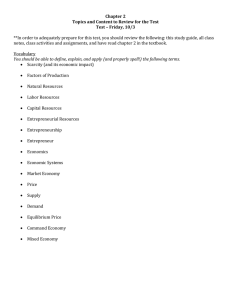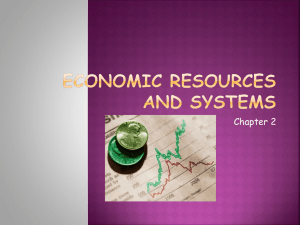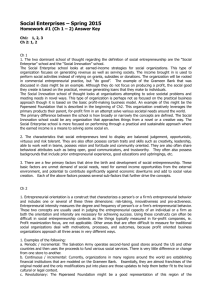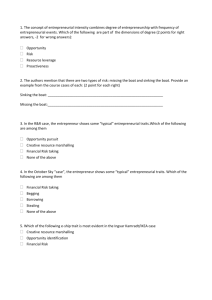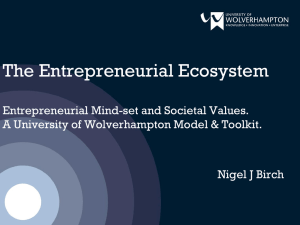Economic Resources: Scarcity & Factors of Production
advertisement
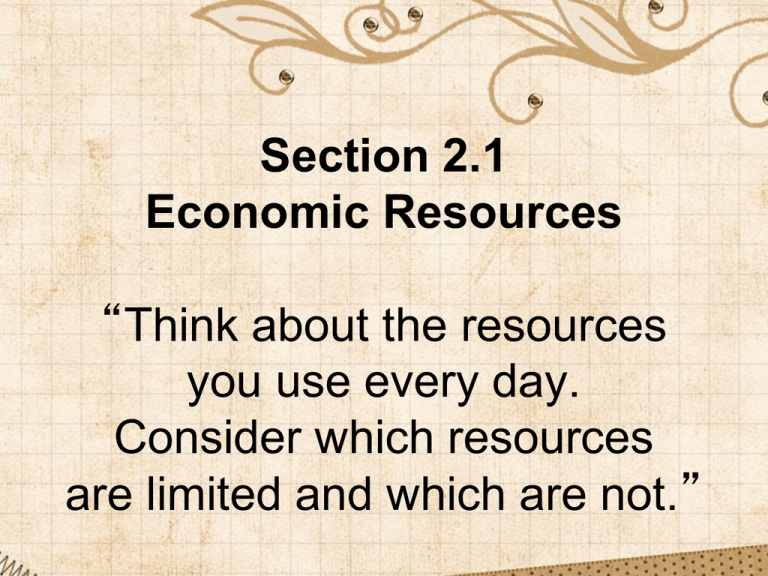
Section 2.1 Economic Resources “Think about the resources you use every day. Consider which resources are limited and which are not.” Key Terms: scarcity, factors of production, natural resources, labor resources, capital resources, entrepreneurial resources, entrepreneurship, entrepreneur Making Economic Decisions Just as individuals have to deal with a shortage of resources, so do societies. In this case resources are the items that go into the making of goods and services. This lack of resources is called scarcity. The principle of scarcity states that there are limited resources for satisfying unlimited wants and needs. Because resources are in limited supply, to have one thing may mean giving up something else. For example, a restaurant owner may forgo plans for a costly new décor to have more money to put kids into kitchen equipment. A city government might decide to cut expenses for most services to be able to hire more police officers. When dealing with scarcity, it is important to think of the best way to use the item that is in short supply. Factors of Production Factors of production are all the economic resources necessary to produce a society’s goods and services, such as the wheat that grows in the ground, the tractor that harvests it, the labor that turns it into flour, and the distribution system that delivers it to the marketplace. There are four factors of production: natural resources, labor resources, capital resources, and entrepreneurial resources. Natural Resources Natural resources are raw materials from nature that are used to produce goods. Trees, water, and grains are natural resources. Natural resources can often be processed in various ways to create goods. Even synthetic or artificially produced materials are made my combining or changing natural resources. For example, nylon is a synthetic material derived from coal, water, and air. The economy of many countries is primarily based on its natural resources. For example, some Latin American countries rely on their coffee and banana crops. Other countries, such as Japan, have little land and scarce natural resources and must get them from somewhere else. Some natural resources, such as wheat and cattle, are renewable. They can be reproduced. You can breed cattle to make more cattle. Other resources are limited, or nonrenewable. Coal, iron, and oil are nonrenewable. The amount of natural resources available to a society has a direct effect on its economy. Labor Resources Every type of business needs labor resources to produce goods and provide services. Labor resources are people who make the goods and services for which they are paid. Labor can be skilled or unskilled, physical or intellectual. Teachers, coal miners, bank managers, and farm workers are all human resources. Whether you are a cashier or a new anchor, you are a labor resource. Capital Resources Capital resources make up another factor of production. Capital resources are not the same as capital, or money. Capital resources are the things used to produce goods and services, such as buildings, materials, and equipment. They are also called capital goods. They include delivery trucks, supermarkets, cash registers, and medical supplies. A tractor that a farmer uses to harvest wheat is a capital resource. The headquarters of a major firm is a capital resource. If you are a writer or an accountant, the computer you use is a capital resource. Entrepreneurial Resources Entrepreneurial resources meet society’s changing wants and needs. Entrepreneurial resources are used by the people who recognize opportunities and start businesses. Entrepreneurship is the process of recognizing a business opportunity, testing it in the market, and gathering the resources necessary to start and run a business. An entrepreneur is an individual who undertakes the creation, organization, and ownership of a business. He or she accepts the risks and responsibilities of business ownership to gain profits and satisfaction. Being entrepreneurial means acting and thinking like an entrepreneur. Entrepreneurial resources are different from labor resources, even though people provide both. Entrepreneurial resources are individuals who start and direct businesses to produce goods and services to satisfy needs or wants. Labor resources are people who produce the goods or services. Review Key Concepts 1. Why do all nations face the problems of scarcity? 2. Identify one similarity and one difference between labor and entrepreneurial resources. 3. List five different natural resources. 4. Think of a product you own. What factors of productions were involved in creating it? For each situation… a) tell what item is scarce b) identify which factor of production is MOST affected by the situation AND tell why
